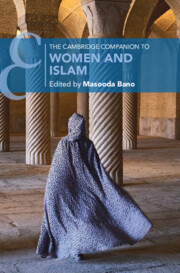Book contents
- The Cambridge Companion to Women and Islam
- Cambridge Companions to Religion
- The Cambridge Companion to Women and Islam
- Copyright page
- Contents
- Contributors
- Preface
- A Note on Foreign-Language Words
- Introduction
- Part I Logic of Classical Reasoning
- 1 Women in the Qur’an
- 2 Women’s Inheritance
- 3 Veiling and Restrictions on Sexual Liberty
- 4 Muhammad: The Ideal Man
- 5 Prophet’s Wives: “Mothers of the Believers”
- Part II Asserting Agency in Faith
- Part III Asserting Agency in Socio-Political Life
- Volume Bibliography
- Index
- Cambridge Companions To … (continued from page ii)
- References
5 - Prophet’s Wives: “Mothers of the Believers”
from Part I - Logic of Classical Reasoning
Published online by Cambridge University Press: 12 April 2025
- The Cambridge Companion to Women and Islam
- Cambridge Companions to Religion
- The Cambridge Companion to Women and Islam
- Copyright page
- Contents
- Contributors
- Preface
- A Note on Foreign-Language Words
- Introduction
- Part I Logic of Classical Reasoning
- 1 Women in the Qur’an
- 2 Women’s Inheritance
- 3 Veiling and Restrictions on Sexual Liberty
- 4 Muhammad: The Ideal Man
- 5 Prophet’s Wives: “Mothers of the Believers”
- Part II Asserting Agency in Faith
- Part III Asserting Agency in Socio-Political Life
- Volume Bibliography
- Index
- Cambridge Companions To … (continued from page ii)
- References
Summary
Mahjabeen Dhala provides insight into how the wives of the Prophet Muhammad serve as role models for Muslim women. The chapter demonstrates how these women chose to live by the high moral standards expected of them and exercised agency not only within traditional roles but also in the socio-political life of the nascent Muslim community.
- Type
- Chapter
- Information
- The Cambridge Companion to Women and Islam , pp. 124 - 144Publisher: Cambridge University PressPrint publication year: 2025

